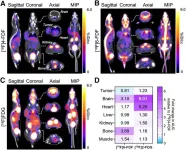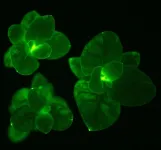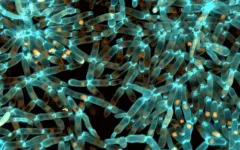(Press-News.org) The body self-regulates in a process known as homeostasis, and the brain is responsible for this
as it is constantly monitoring all of the body’s vital signals. If you need more oxygen, for
example, then a message is sent to the brain that then tells the body to adjust your breathing
and your heart rate. But the neurons involved in regulating breathing and cardiac rhythm had
never been directly observed, until now, thanks to brain recording technology during brain
surgery.
EPFL neuroscientists, in a collaboration with surgeons and neuroscientists at West Virginia
University Rockefeller Neuroscience Institute and at the University of North Carolina at Chapel
Hill, show that single neurons deep in the human brain, in two thalamic nuclei and the
subthalamic nucleus, encode vital physiological signals from the heart and lungs, providing the
first direct evidence of this in humans. The results are published in PNAS.
“Neural connections between the body’s inner organs and the brain had been hypothesized
based on rare animal research and existing anatomical work,” explains first author Emanuela De
Falco of EPFL’s Laboratory of Cognitive Neuroscience, led by Olaf Blanke. “We found that
cardio-respiratory signals affect a large portion of neurons.”
Marco Solca, co-first author of the study continues, “Locating these neurons is relevant since it
sheds light on how this body-brain communication happens in the deep brain.”
Communication between the body and brain is also known to be relevant for several important
cognitive and affective processes as it influences, for example, visual detection, emotional
regulation and decision-making. Dysfunction of the body-brain communication is recognized as
an important feature of various mental health conditions, including anxiety, mood, eating, and
psychosomatic disorders.
A unique opportunity with deep brain stimulation
The study was carried out over several years, thanks to a collaboration with Dr. Ali Rezai,
neurosurgeon and director of the West Virginia University Rockefeller Neuroscience Institute,
by recording the activity of single neurons in patients undergoing surgery for deep-brain
stimulation (DBS) to treat various medical conditions.
DBS consists of stimulating neurons deep inside the brain via an electrode probe. Before
inserting the probe, neurosurgeons sometimes opt to temporarily insert a microelectrode into
the brain and make recordings of brain activity, since it improves where in the brain the DBS
probe is subsequently inserted. As in previous projects, the EPFL scientists saw the potential in
these microelectrode recordings, and seized the opportunity to monitor electrocardiograms
simultaneously, thus obtaining coupled recordings of the neuron activity and different cardiac
and respiratory signals.
“Now we know where these neurons are located, immediate future studies could focus on
understanding the feedback loop mechanism between the heartrate and neural activity in
subcortical areas of the brain and their involvement in self-consciousness and
movement intentions or free will,” says De Falco. “More generally, this study lays the
foundation for several future developments, towards understanding the brain and more
broadly in psychiatric conditions.”
END
Locating single neurons that monitor and regulate the heart and lungs
2024-03-08
ELSE PRESS RELEASES FROM THIS DATE:
Primary care scarcity linked to more surgical emergencies & problems
2024-03-08
America’s shortage of primary care doctors and nurse practitioners has a downstream effect in the nation’s operating rooms, a new study finds.
And patients suffer as a result.
In all, people living in areas with the most severe shortages of primary care providers have a much higher risk of having emergency surgery, rather than a scheduled operation,
compared with people with the same condition who live in areas with less-dire primary care shortages.Those living in the areas with the lowest availability of primary care providers ...
Novel PET tracer maps fructose metabolism to identify cardiac and neural disorders
2024-03-08
Reston, VA—A new PET radiotracer can differentiate diseased tissues from healthy tissues based on fructose metabolism, according to new research published in the March issue of The Journal of Nuclear Medicine. Fructose metabolism—or fructolysis—is indicative of a variety of diseases, and by noninvasively mapping fructolysis physicians can more accurately detect diseases and treat them earlier.
Glucose is used as the primary biochemical fuel throughout the body, powering key processes like tissue function, growth, and repair. Glucose is also consumed extensively during inflammation and cancer growth and can be visualized with PET scans. Evidence continues to mount that ...
Pushing the boundary on ultralow frequency gravitational waves
2024-03-08
A team of physicists has developed a method to detect gravity waves with such low frequencies that they could unlock the secrets behind the early phases of mergers between supermassive black holes, the heaviest objects in the universe.
The method can detect gravitational waves that oscillate just once every thousand years, 100 times slower than any previously measured gravitational waves.
“These are waves reaching us from the farthest corners of the universe, capable of affecting how light travels,” said Jeff Dror, Ph.D., an assistant ...
New study reveals molecular fingerprint of biological aging
2024-03-08
University of Pittsburgh researchers have uncovered blood-based markers linked with healthy and rapid aging, allowing them to predict a person’s biological age — how fast a person’s cells and organs age regardless of their birthdate.
The new research, published in Aging Cell, points to pathways and compounds that may underlie biological age, shedding light on why people age differently and suggesting novel targets for interventions that could slow aging and promote healthspan, the length of time a person is healthy.
“Age is more than just a number,” said senior author Aditi Gurkar, Ph.D., assistant professor of geriatric medicine at ...
Glowing flowers illuminate homes and gardens with organic light
2024-03-08
Sun Valley, ID - March 8, 2024 – Recent discoveries published in Science Advances have unveiled a native plant gene that enables researchers to more effortlessly harness the captivating glow of bioluminescent plants. This gene, which varies across different plant species, allows for the redirection of living energy into organic light. The advancement reveals the intricate inner rhythms and dynamics of plants through continuously evolving luminosity, offering a natural source of illumination for homes, gardens, and beyond.
The study received support from Light Bio, a pioneer in the development of bioluminescent plants. Light Bio is dedicated to fostering ...
Research sheds light on new strategy to treat infertility
2024-03-08
New research from Oregon Health & Science University describes the science behind a promising technique to treat infertility by turning a skin cell into an egg that is capable of producing viable embryos.
Researchers at OHSU documented in vitro gametogenesis, or IVG, in a mouse model through the preliminary steps of a technique that relies upon transferring the nucleus of a skin cell into a donated egg whose nucleus has been removed. Experimenting in mice, researchers coaxed the skin cell’s nucleus into reducing its chromosomes by half, so that it could then be fertilized ...
The brain builds emotions regardless of the senses
2024-03-08
How much do our emotions depend on our senses? Does our brain and body react in the same way when we hear a fearful scream, see an eerie shadow, or smell a sinister odor? And does hearing an upbeat music or seeing a colorful landascape bring the same joy?
In an innovative study published in Science Advances, researchers have unveiled new insights into the intricate relationship between emotion and perception.
Led by a team of Italian neuroscientists from the IMT School for Advanced Studies Lucca, and conducted in collaboration with the University of Turin, the research project investigates whether the brain employs sensory-specific or abstract codes to construct ...
Harnessing the mechanisms of fungal bioluminescence to confer autonomous luminescence in plants and animal cells
2024-03-08
In a striking new study published today in Science Advances, a team of synthetic biologists led by Karen Sarkisyan at the MRC Laboratory of Medical Sciences, have reported the discovery of multiple plant enzymes – hispidin synthases – that can perform the most complex reaction of the bioluminescence pathway. This discovery is a significant milestone towards figuring out whether plants can natively produce all the molecules required for light emission. It also means that the glow of bioluminescent plants can now be more closely aligned with their internal biology.
The technology reported in the paper is a hybrid ...
New study discovers how altered protein folding drives multicellular evolution
2024-03-08
Researchers have discovered a mechanism steering the evolution of multicellular life. They identified how altered protein folding drives multicellular evolution.
In a new study led by researchers from the University of Helsinki and the Georgia Institute of Technology, scientists turned to a tool called experimental evolution. In the ongoing Multicellularity Long Term Evolution Experiment (MuLTEE), laboratory yeast are evolving novel multicellular functions, enabling researchers to investigate how they arise.
The study puts the spotlight on the regulation of proteins in understanding evolution.
"By demonstrating the effect of protein-level ...
Socially prescribed creative play boosts parents’ and children’s wellbeing
2024-03-08
University of Leeds news
For immediate release
Socially prescribed creative play boosts parents’ and children’s wellbeing
Socially prescribed creative play helps children and their parents develop new skills and promotes wellbeing, a new study has found.
The University of Leeds-led study evaluated a five-week programme of arts-based play, including singing and music-making, for families of children aged up to three. It found that parents benefited from developing social networks and sharing experiences with each other, as well as learning creative approaches to parenting. ...




